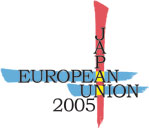by Siglinde Kallnbach


Welcoming address
by
Prof. Georg Quander,
Head of the Cultural Affairs Department of the City of Cologne in
Germany
to Rhinegold-Shinkansen, an exhibition of Siglinde
Kallnbach’s work in JAPAN
exhibition
"Rheingold
- Shinkansen" in Japan by Siglinde Kallnbach |
  |
Deutschland/NRW
in Japan 2005/ 2006 - Germany/North Rhine - Westphalia in Japan 2005/2006
Under this heading,Germany/North Rhine Westphalia is presenting itself in Japan
in 2005 and 2006. Apart from business and scientific projects, extensive cultural
encounters will be taking place which continue and intensify the cultural dialogue
between the two countries.
The exhibition of Siglinde Kallnbach's works, Rhinegold-Shinkansen, presents
Germany not only as a cultured nation, but also as a country of creativity and
the fine arts. I am happy that the Cologne artist, Siglinde Kallnbach, is able
to present a selection of her creative artistic work in Japan within this context.
This seems to be logical and consistent because it has often been toward Japan
that Siglinde Kallnbach has directed her artistic efforts.
Initial ties with Japan came about at the beginning of the 1980s. A recent exhibition
in 2000 was shown at the Japanese Cultural Institute in Cologne together with
works of the Japanese artist, Shozo Shimamoto, as part of a cultural exchange
under the heading Japan in Germany 2000. Two years later, in 2002, Siglinde
Kallnbach had a three-month stay in northern Japan supported by a grant during
which she first came into contact with Nebuta*. In her installation there, Shrines,
in which photographs, 32 large drawings, a video and other works were presented,
this encounter had already been taken up.
The desire to track down the focus of Siglinde Kallnbach’s cross-media
artistic work over more than thirty years leads straight to a centrally important
medium of expression for her work.
In innumerable artistic performances, she has made her own body into a motor
and simultaneously a medium. Her body has unsparingly served her as a tool for
incisive and uncompromising live performances. Some of her spectacularly provocative
artistic performances, with which she risked breaking taboos at the beginning
of the 1980s, provoked nationwide scandals and ignited heated discussions in
the media about the limits of art and about what art may do and what it must
not do. Even though at that time some galleries lost the courage against these
resistances to continue showing Siglinde Kallnbach's work, the artist did not
allow herself to be held back and continued following her own path which led
her unerringly onto the stage of the national and international art scenes.
If one rolls out one of her more recent works from 1999/2001, the viewer will
follow a very special track. Wishingtrack leads to personal statements in words
and images by people living in the twenty-first century which had been taken
up and compiled by the artist in many countries of the world over a two-and-a-half
year period. The texts and drawings were processed digitally into code and transferred
to a 'wishingtrack' with a length of 461 metres. Transformed into this abstract
representation, the artist unrolled the tracks of more than four thousand wishes
on New Year's Eve of the years 1999 and 2000 in a tunnel below the river-bed
of the Rhine River at Cologne.
Wishingtrack visualized important motifs of human existence in our times and
presented the universality of wishing and the commonly shared wish for health,
peace and personal happiness.
In her artistic work, Siglinde Kallnbach is concerned in diverse ways with the
forces of hope. She wants to counter impotence and conceives of her art also
as a political force. Siglinde Kallnbach's way of working and also her language
have changed their tone over the course of years. If in past years the forms
of artistic expression were louder, today Kallnbach finds softer tones which
at the same time resonate powerfully and have not lost any of their intensity.
The title of the current exhibition, Rhinegold-Shinkansen, at the Kita Gallery
of Yamatokooriyama City in Nara Ken takes up the names of legendary trains in
Germany and Japan and is thus a reference to today’s fast living as a
feature of modernity.
The photographs offer a juxtaposition of urban situations, everyday moments
and celebrations, of modern architecture and landscapes in present-day Japan
and Germany. Apart from evidence of modern living liberated from tradition,
the viewer also comes across signs of constancy in everyday culture —
they are photographs of the Nebuta festival* and Carnival in Cologne.
In the context of Siglinde Kallnbach's oeuvre, in these photographs something
of what drove her work on wishingtrack, what characterizes and defines her art
becomes apparent: mobilizing forces, conceiving life as a once-only opportunity
to shape something and transform it into a festival.
Pictures of celebrations, photographs of publicly celebrated, concentrated,
ritualized festivity here symbolize, so to speak, the desire to loosen up cultural
fetters and leave conventions behind, they refer to the potential of celebration
and to the power of art to penetrate into new spaces and introduce others to
them: being able to wish life anew, to strip off and forget what is old, to
become another person, to run through the fire and start again as someone new
on the other side.
Professor Georg Quander
Head of the Cultural Affairs Department of the City of Cologne
*At this festival known throughout Japan, enormous figures are carried through
the streets accompanied by countless dancers. The procession floats are painted
colourfully and illuminated from the inside.
Translated from the
German by Dr. Michael Eldred, artefact text & translation, Cologne